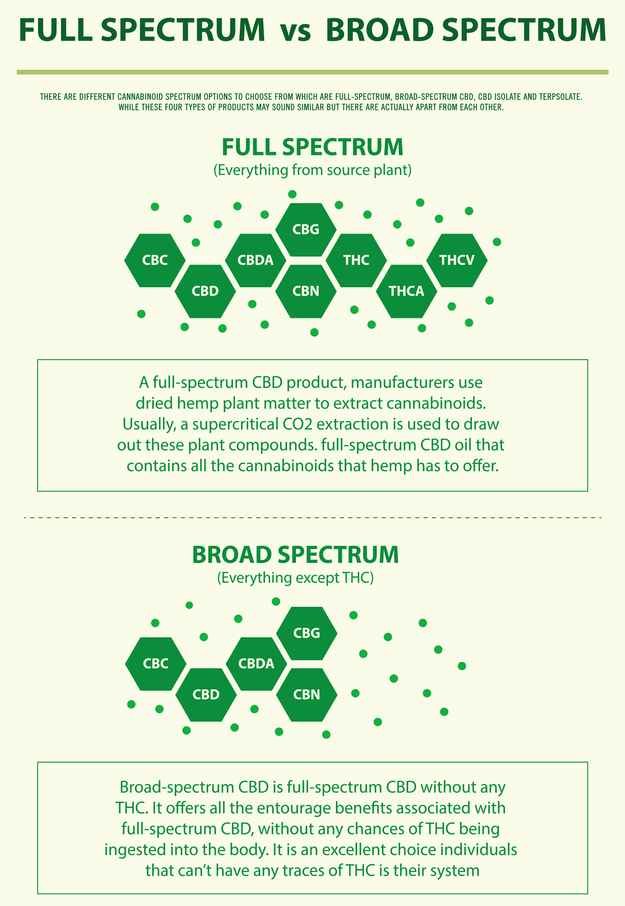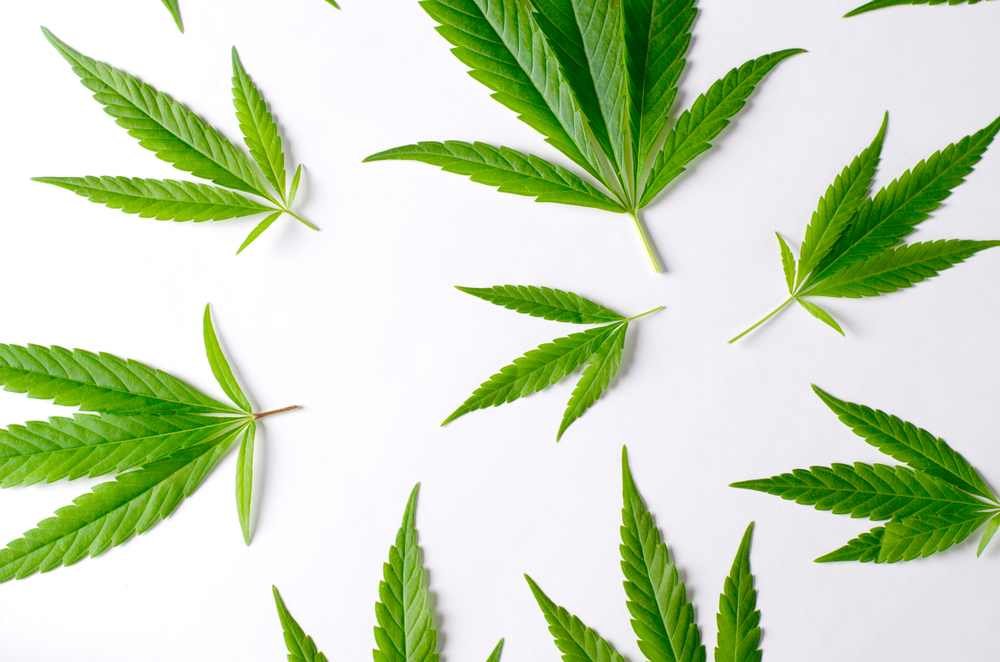If you’ve been exploring CBD products, you’ve probably seen terms like full-spectrum and broad-spectrum on the label. They sound almost identical, but there’s an important difference between the two that affects how they work — and which one might suit you better.
Both come from hemp and contain a mix of cannabinoids and terpenes that can support balance, relaxation, and overall wellness. The main difference? Full-spectrum CBD includes a small, legal amount of THC, while broad-spectrum CBD removes THC completely but keeps the other beneficial compounds.
Understanding this difference can help you choose a product that fits your needs — whether you want the full plant experience or prefer to stay THC-free.
In this article, we’ll break down how each type works, what they have in common, how they differ, and which one may be better for you.
What Is Full-Spectrum CBD?
Full-spectrum CBD is the most natural form of CBD extract. It contains all the compounds found in the hemp plant — including CBD, minor cannabinoids like CBG and CBC, aromatic terpenes, flavonoids, and a trace amount of THC (less than 0.3%).
This small amount of THC isn’t enough to make you feel high, but it plays an important role in what’s called the entourage effect. That’s when all the compounds in hemp work together to enhance each other’s effects, making the product feel stronger and more balanced than CBD alone.
Because full-spectrum CBD keeps the plant’s full profile, it’s often considered the most complete version of CBD. Many people prefer it for managing stress, discomfort, or sleep issues because it delivers a deeper, more well-rounded experience.
What Is Broad-Spectrum CBD?
Broad-spectrum CBD is very similar to full-spectrum, with one key difference: it contains no THC. During extraction, the THC is carefully removed while keeping most of the other natural compounds found in hemp, such as CBD, CBG, CBN, CBC, terpenes, and flavonoids.
This makes broad-spectrum CBD the perfect middle ground between CBD isolate and full-spectrum CBD. You still get the benefits of multiple cannabinoids working together — the entourage effect — but without any THC in your system.
People who choose broad-spectrum CBD often do so because they want the enhanced effects that come from hemp’s natural compounds, but prefer to avoid THC completely — whether for personal comfort, workplace policies, or sensitivity.
Full-Spectrum vs. Broad-Spectrum: Key Similarities
Even though full-spectrum and broad-spectrum CBD differ slightly, they share many of the same benefits and qualities. Here are the main similarities between the two:
1. Both Come from Hemp
Full-spectrum and broad-spectrum CBD are both extracted from legally grown hemp plants that contain less than 0.3% THC. That means both types are federally legal in the U.S. under the 2018 Farm Bill.
2. Both Contain Multiple Cannabinoids and Terpenes
Unlike CBD isolate, these two extracts retain a variety of cannabinoids and terpenes. These natural compounds contribute to the entourage effect, which enhances the potential benefits of CBD.
3. Both Are Non-Intoxicating
Neither full-spectrum nor broad-spectrum CBD will make you feel high. Even though full-spectrum includes trace THC, the amount is too low to cause any psychoactive effects.
4. Both Offer a Range of Wellness Benefits
Users turn to both types for similar reasons — to promote calm, support better sleep, ease discomfort, and maintain general wellness. The difference lies only in how complete the plant profile is.
5. Both Come in the Same Forms
You’ll find both types in familiar options like CBD oils, gummies, capsules, and topicals. The choice mainly depends on personal preference and THC tolerance, not product type.
Full-Spectrum vs. Broad-Spectrum: Main Differences
Full-spectrum and broad-spectrum CBD may look alike on the surface, but one small detail sets them apart — THC. That difference can affect how the product feels, how it’s used, and who it’s best suited for.
Here’s a quick comparison to help you see how they differ:
Feature | Full-Spectrum CBD | Broad-Spectrum CBD |
|---|---|---|
| THC Content | Contains trace THC (less than 0.3%) | THC is completely removed |
| Entourage Effect | Stronger, due to THC’s contribution | Mild to moderate, still present without THC |
| Processing Level | Minimal — keeps all hemp compounds | An extra step has been added to remove THC |
| Flavor Profile | Earthy, natural hemp taste | Slightly lighter or milder flavor |
| Ideal For | Users are comfortable with trace THC or seeking stronger effects | Users avoiding THC but still wanting enhanced benefits |
| Drug Test Risk | Slight possibility | None (if tested and verified THC-free) |
In simple terms:
Full-spectrum CBD gives you everything the hemp plant offers, including THC for a stronger entourage effect.
Broad-spectrum CBD gives you nearly the same benefits, just without THC — perfect for those who want to play it safe.
Both options can be highly effective; the difference comes down to your comfort level with THC and how your body responds to it.

Pros and Cons of Each
Both full-spectrum and broad-spectrum CBD offer real benefits, but each comes with its own trade-offs.
Full-Spectrum CBD
Pros
Complete Hemp Profile: Contains all cannabinoids, terpenes, and flavonoids for a natural, whole-plant experience.
Stronger Entourage Effect: Trace THC works together with other compounds for enhanced balance and relief.
Less Processed: Keeps the hemp extract as close to its original form as possible.
May Offer Deeper Results: Many users report stronger effects for pain, stress, and sleep support.
Cons
Contains Trace THC: Legal and non-intoxicating, but could still appear on some drug tests.
Earthy Flavor: The natural hemp taste can be strong in oils or tinctures.
Not Ideal for Everyone: Those who prefer to avoid THC may find it unsuitable.
Broad-Spectrum CBD
Pros
THC-Free: Offers peace of mind for anyone avoiding THC for personal, professional, or legal reasons.
Balanced Effects: Retains multiple cannabinoids and terpenes for a milder form of the entourage effect.
Gentler Flavor: Typically smoother and easier to consume than full-spectrum extracts.
Safe for Daily Use: Works well for people who want consistent results without THC exposure.
Cons
Slightly Weaker Entourage Effect: Removing THC reduces the overall effects of the other compounds.
More Processed: Requires an extra refinement step to eliminate THC.
Effectiveness Varies: Some users find it less potent than full-spectrum CBD for stronger needs.
Which One Should You Choose?
Choosing between full-spectrum and broad-spectrum CBD really comes down to your comfort level with THC and what kind of experience you’re looking for.
Go for Full-Spectrum CBD if:
You’re okay with trace amounts of THC (less than 0.3%).
You want the strongest entourage effect possible for deeper relaxation, pain relief, or sleep support.
You prefer a more natural, unfiltered hemp experience.
You don’t have to worry about regular drug testing.
Choose Broad-Spectrum CBD if:
You want the benefits of multiple cannabinoids without any THC at all.
You’re sensitive to THC or need to avoid it for personal or professional reasons.
You want a balanced experience that’s effective but slightly gentler.
You prefer a cleaner taste and a product that feels a bit lighter.
Still unsure?
Start with broad-spectrum CBD. It’s a safe middle ground — you’ll still enjoy the natural combination of hemp’s compounds without worrying about THC. Later, if you want a stronger effect, you can always try full-spectrum.
FAQs
1. Which is stronger — full-spectrum or broad-spectrum CBD?
Full-spectrum CBD is usually considered stronger because it includes trace THC, which helps boost the entourage effect. Broad-spectrum offers similar benefits but feels slightly milder since THC is removed.
2. Can broad-spectrum CBD cause a failed drug test?
It’s very unlikely. Broad-spectrum products are made to be completely THC-free, but to be safe, always check the Certificate of Analysis (COA) to confirm THC is listed as “non-detectable.”
3. Does full-spectrum CBD make you high?
No. Even though it contains trace THC (under 0.3%), that’s nowhere near enough to cause a high. Most people simply feel calm, relaxed, or more balanced.
4. Which works better for anxiety or stress relief?
Both can help. Many users find full-spectrum CBD slightly more effective for anxiety and relaxation because of the added effects from THC and terpenes. However, broad-spectrum is ideal if you want those calming effects without THC exposure.
5. Is broad-spectrum CBD completely THC-free?
Yes. True broad-spectrum products go through an extra refinement step to remove all THC while keeping other cannabinoids and terpenes intact.
6. Is full-spectrum CBD legal in the U.S.?
Yes, as long as the THC content stays below 0.3% — which is the legal limit under the 2018 Farm Bill. Still, it’s important to buy from trusted brands that share lab reports for every batch.
7. Can I switch between full-spectrum and broad-spectrum?
Absolutely. Some users take full-spectrum at night for stronger relaxation and use broad-spectrum during the day for focus or energy. It’s safe to mix and match as long as you monitor how your body responds.
8. Which is better for beginners?
Broad-spectrum CBD is often the best starting point. It provides well-rounded effects without THC, making it easier to get comfortable with how CBD interacts with your system.
Final Thoughts
Both full-spectrum and broad-spectrum CBD offer powerful ways to experience the natural benefits of hemp — they just take slightly different paths to get there.
If you want the most complete plant experience and don’t mind trace amounts of THC, full-spectrum CBD might give you the deeper results you’re looking for. It’s the best option if you want to feel the full entourage effect at work.
If you prefer to avoid THC altogether but still want the enhanced benefits that come from multiple cannabinoids and terpenes, broad-spectrum CBD is your best fit. It’s clean, effective, and safe for everyday use.
At the end of the day, neither is “better” for everyone — it’s about what fits you. Start slow, check your product’s lab results, and see how your body responds. With consistent use and the right choice, you can enjoy all the calm, balance, and wellness that CBD has to offer.
Disclosure:
The information provided in this article is meant for general use only and may not always suit everyone’s individual needs. Your health and wellness are personal, so consult a medical professional for personalized advice before making decisions based on this content.
For more information, please read our Disclosure Policy.

